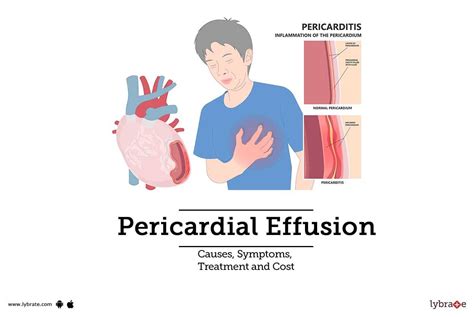The pericardium, a sac surrounding the heart, plays a crucial role in maintaining cardiac function by producing fluid that lubricates the heart, allowing it to move smoothly within the chest cavity. However, when this fluid accumulates excessively, a condition known as pericardial effusion occurs. This accumulation can lead to increased pressure on the heart, potentially compromising its ability to function properly. Pericardial effusion symptoms can range from mild to severe and may develop rapidly or gradually, depending on the underlying cause.
Understanding Pericardial Effusion
Pericardial effusion is characterized by an abnormal accumulation of fluid in the pericardial space, the area between the heart and the pericardium. This condition can be acute or chronic. Acute pericardial effusion develops suddenly and may be life-threatening, whereas chronic pericardial effusion develops over time and may cause milder symptoms initially.
Causes of Pericardial Effusion
Several factors can lead to pericardial effusion, including: - Infections: Viral, bacterial, or fungal infections can cause inflammation of the pericardium, leading to fluid accumulation. - Trauma: Chest injuries can result in bleeding into the pericardial space. - Cancer: Tumors, either primary (originating in the pericardium) or metastatic (spreading from other parts of the body), can cause pericardial effusion. - Autoimmune Disorders: Conditions like lupus or rheumatoid arthritis can lead to inflammation of the pericardium. - Kidney Failure: Excessive fluid can accumulate due to the body’s inability to filter and remove waste and fluids effectively. - Heart Attack: Myocardial infarction can cause fluid to leak into the pericardial space.
Symptoms of Pericardial Effusion
Symptoms can vary depending on the amount of fluid accumulated and the speed at which it accumulates. Common symptoms include: - Chest Pain: Sharp or dull pain in the center of the chest that may radiate to the neck, shoulders, or arms. The pain can worsen with deep breathing or lying down. - Shortness of Breath: Difficulty breathing (dyspnea) that can be severe and may worsen when lying down. - Fatigue: Feeling extremely tired or weak. - Cough: A dry, persistent cough. - Fever: Elevated body temperature, especially if the effusion is due to an infection. - Palpitations: Irregular heartbeats that may feel like pounding or fluttering.
Severe Symptoms
In cases of large pericardial effusions or those that accumulate rapidly, symptoms can become severe and life-threatening, including: - Cardiac Tamponade: A condition where the fluid accumulation puts significant pressure on the heart, impeding its ability to pump blood effectively. Symptoms can include severe chest pain, fainting (syncope), and low blood pressure. - Shock: A life-threatening condition that occurs when the body is not getting enough blood flow.
Diagnosis and Treatment
Diagnosis involves a combination of physical examination, electrocardiogram (ECG), chest X-ray, and echocardiogram. Treatment aims to address the underlying cause and may include: - Pericardiocentesis: A procedure to remove excess fluid from the pericardial space. - Medications: To treat the underlying cause, such as antibiotics for infections or anti-inflammatory drugs for autoimmune disorders. - Surgery: In some cases, surgical intervention may be necessary to remove part of the pericardium or to treat the underlying cause.
Prevention
While not all cases of pericardial effusion can be prevented, managing underlying health conditions, such as high blood pressure, and seeking prompt medical attention for any signs of infection or trauma can help mitigate the risk.
Conclusion
Pericardial effusion is a serious condition that requires timely medical intervention. Recognizing the symptoms and understanding the causes can help individuals seek the necessary care. With appropriate treatment, many people can recover from pericardial effusion, and in some cases, preventive measures can reduce the risk of developing the condition.
FAQ Section
What is the primary symptom of pericardial effusion?
+Chest pain is a primary symptom, which can be sharp or dull and may radiate to the neck, shoulders, or arms.
Can pericardial effusion be life-threatening?
+Yes, large or rapidly accumulating pericardial effusions can lead to cardiac tamponade or shock, both of which are life-threatening conditions.
How is pericardial effusion diagnosed?
+Diagnosis involves a physical examination, ECG, chest X-ray, and echocardiogram. The echocardiogram is particularly useful for visualizing the fluid accumulation around the heart.
Can pericardial effusion be treated?
+Is it possible to prevent pericardial effusion?
+While not all cases can be prevented, managing underlying health conditions and seeking prompt medical attention for signs of infection or trauma can help reduce the risk.
Understanding pericardial effusion and its symptoms is crucial for early detection and effective management. By recognizing the signs and seeking medical care promptly, individuals can improve their outcomes and reduce the risk of complications.



